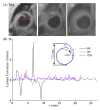Characterization of healing following atherosclerotic carotid plaque rupture in acutely symptomatic patients: an exploratory study using in vivo cardiovascular magnetic resonance
- PMID: 22032404
- PMCID: PMC3215655
- DOI: 10.1186/1532-429X-13-64
Characterization of healing following atherosclerotic carotid plaque rupture in acutely symptomatic patients: an exploratory study using in vivo cardiovascular magnetic resonance
Abstract
Background: Carotid plaque rupture, characterized by ruptured fibrous cap (FC), is associated with subsequent cerebrovascular events. However, ruptured FC may heal following stroke and convey decreased risk of future events. This study aims to characterize the healing process of ruptured FC by assessing the lumen conditions, quantified by the lumen curvature and roughness, using in vivo carotid cardiovascular magnetic resonance (CMR).
Methods: Patients suffering from transient ischemic attack underwent high resolution carotid MR imaging within 72 hours of the acute cerebrovascular ischemic event. CMR imaging was repeated at 3 and 12 months in 26 patients, in whom FC rupture/erosion was observed on baseline images and subsequent cerebrovascular events were recorded during the follow-up period. Lumen curvature and roughness were quantified from carotid CMR images and changes in these values were monitored on follow-up imaging.
Results: Healing of ruptured plaque was observed in patients (23 out of 26) without any ischemic symptom recurrence as shown by the lumen surface becoming smoother during the follow-up period, characterized by decreasing maximum lumen curvature (p < 0.05), increasing minimum lumen curvature (p < 0.05) and decreasing lumen roughness (p < 0.05) during the one year follow-up period.
Conclusions: Carotid plaque healing can be assessed by quantification of the lumen curvature and roughness and the incidence of recurrent cerebrovascular events may be high in plaques that do not heal with time. The assessment of plaque healing may facilitate risk stratification of recent stroke patients on the basis of CMR results.
Figures




Similar articles
-
The relationship between fibrous cap status or plaque surface morphology and intraplaque hemorrhage volume over time: The PARISK Study.J Stroke Cerebrovasc Dis. 2025 May;34(5):108283. doi: 10.1016/j.jstrokecerebrovasdis.2025.108283. Epub 2025 Mar 12. J Stroke Cerebrovasc Dis. 2025. PMID: 40081118
-
Carotid plaques in transient ischemic attack and stroke patients: one-year follow-up study by magnetic resonance imaging.Invest Radiol. 2010 Dec;45(12):803-9. doi: 10.1097/RLI.0b013e3181ed15ff. Invest Radiol. 2010. PMID: 20829705
-
Co-existing cerebrovascular atherosclerosis predicts subsequent vascular event: a multi-contrast cardiovascular magnetic resonance imaging study.J Cardiovasc Magn Reson. 2020 Jan 13;22(1):4. doi: 10.1186/s12968-019-0596-6. J Cardiovasc Magn Reson. 2020. PMID: 31928532 Free PMC article.
-
Contemporary carotid imaging: from degree of stenosis to plaque vulnerability.J Neurosurg. 2016 Jan;124(1):27-42. doi: 10.3171/2015.1.JNS142452. Epub 2015 Jul 31. J Neurosurg. 2016. PMID: 26230478 Review.
-
Imaging of the fibrous cap in atherosclerotic carotid plaque.Cardiovasc Intervent Radiol. 2010 Aug;33(4):681-9. doi: 10.1007/s00270-010-9828-8. Epub 2010 Mar 17. Cardiovasc Intervent Radiol. 2010. PMID: 20237780 Review.
Cited by
-
Three-dimensional identification of microorganisms using a digital holographic microscope.Comput Math Methods Med. 2013;2013:162105. doi: 10.1155/2013/162105. Epub 2013 Mar 31. Comput Math Methods Med. 2013. PMID: 23606897 Free PMC article.
-
Advances in MRI for the evaluation of carotid atherosclerosis.Br J Radiol. 2015 Aug;88(1052):20140282. doi: 10.1259/bjr.20140282. Epub 2015 Mar 31. Br J Radiol. 2015. PMID: 25826233 Free PMC article. Review.
-
Dimensionality reduction by supervised neighbor embedding using laplacian search.Comput Math Methods Med. 2014;2014:594379. doi: 10.1155/2014/594379. Epub 2014 May 21. Comput Math Methods Med. 2014. PMID: 24963339 Free PMC article.
-
The MRI enhancement ratio and plaque steepness may be more accurate for predicting recurrent ischemic cerebrovascular events in patients with intracranial atherosclerosis.Eur Radiol. 2022 Oct;32(10):7004-7013. doi: 10.1007/s00330-022-08893-2. Epub 2022 Jun 30. Eur Radiol. 2022. PMID: 35771249
-
Residual risks and evolving atherosclerotic plaques.Mol Cell Biochem. 2023 Dec;478(12):2629-2643. doi: 10.1007/s11010-023-04689-0. Epub 2023 Mar 10. Mol Cell Biochem. 2023. PMID: 36897542 Free PMC article. Review.
References
-
- Sadat U, Teng Z, Young VE, Walsh SR, Li ZY, Graves MJ, Varty K, Gillard JH. Association between biomechanical structural stresses of atherosclerotic carotid plaques and subsequent ischaemic cerebrovascular events--a longitudinal in vivo magnetic resonance imaging-based finite element study. Eur J Vasc Endovasc Surg. 2010;40:485–491. doi: 10.1016/j.ejvs.2010.07.015. - DOI - PubMed
-
- Takaya N, Yuan C, Chu B, Saam T, Underhill H, Cai J, Tran N, Polissar NL, Isaac C, Ferguson MS. et al.Association between carotid plaque characteristics and subsequent ischemic cerebrovascular events: a prospective assessment with MRI--initial results. Stroke. 2006;37:818–823. doi: 10.1161/01.STR.0000204638.91099.91. - DOI - PubMed
Publication types
MeSH terms
Grants and funding
LinkOut - more resources
Full Text Sources
Medical
Miscellaneous

